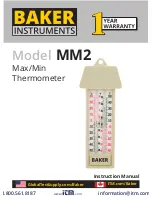
UM RTD.2
General
Technical changes reserved
- 9 -
1.3.6 Making measurements
The measuring leads and wires must be in good condition and must be replaced if their insulation ap-
pears faulty (insulating material cut, burned, etc...).
When the instrument is connected to the measuring circuits the terminals can be dangerous, therefore
do not place your hands near a terminal, whether used or not.
Never exceed the protection value limits indicated in the specifications.
When the order of size of the measured value is not known, ensure that the starting measurement
range is has high as possible, or select automatic range change mode.
Before changing function, disconnect the measuring wires from the external circuit. When voltage
measurements are being made, even weak ones, keep in mind that the circuits may feature a dan-
gerous voltage for the operator compared to the ground.
Do not make any measurements when the device is linked up to another device using the USB link or
when the batteries are being charged (option).
1.3.7 Defects and abnormal stresses
Every time you believe the protection may have been compromised, switch off the device and prevent
it from being switched back on unexpectedly.
The protection may be impaired in the following cases, for example:
•
The device is visibly worn.
•
The device is no longer able to make precise measurements.
•
The device was stored in unfavourable conditions.
•
The device has undergone severe stresses during transport.
1.3.8 Definitions
1.3.8.1 Definition of the category and degree of pollution
CAT II 60V:
The notion of categories determines the maximum transient voltage that can be applied to the meas-
urement inputs (it is also called overvoltage category). For the SIKA UM RTD.2, the maximum per-
missible overvoltage is 60V (DC or AC)
POL 2:
The notion of pollution determines the clearance between circuits. Degree 2 authorises temporary
conductivity caused by condensation.










































